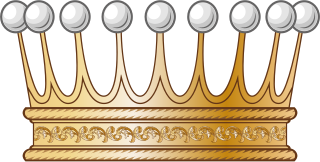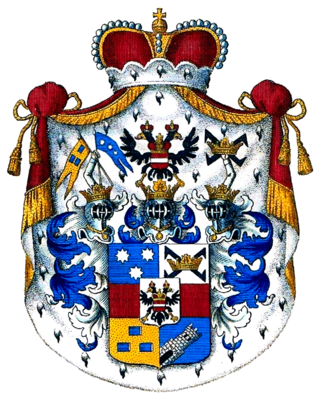Styles represent the fashion by which monarchs and noblemen are properly addressed. Throughout history, many different styles were used, with little standardization. This page will detail the various styles used by royalty and nobility in Europe, in the final form arrived at in the nineteenth century.
A prince is a male ruler or a male member of a monarch's or former monarch's family. Prince is also a title of nobility, often hereditary, in some European states. The female equivalent is a princess. The English word derives, via the French word prince, from the Latin noun prīnceps, from primus (first) and caput (head), meaning "the first, foremost, the chief, most distinguished, noble ruler, prince".
Grand duke is a European hereditary title, used either by certain monarchs or by members of certain monarchs' families. In status, a grand duke traditionally ranks in order of precedence below an emperor, equal to a King, grand prince, archduke, or prince-archbishop, and above a sovereign prince or sovereign duke. The title is used in some current and former independent monarchies in Europe, particularly:
A style of office or form of address, also called manner of address, is an official or legally recognized form of address for a person or other entity, and may often be used in conjunction with a personal title. A style, by tradition or law, precedes a reference to a person who holds a post or political office, and is sometimes used to refer to the office itself. An honorific can also be awarded to an individual in a personal capacity. Such styles are particularly associated with monarchies, where they may be used by a wife of an office holder or of a prince of the blood, for the duration of their marriage. They are also almost universally used for presidents in republics and in many countries for members of legislative bodies, higher-ranking judges, and senior constitutional office holders. Leading religious figures also have styles.
Fürst is a German word for a ruler as well as a princely title. Fürsten were, starting in the Middle Ages, members of the highest nobility who ruled over states of the Holy Roman Empire and later its former territories, below the ruling Kaiser (emperor) or König (king).

Graf is a historical title of the German nobility and later also of the Russian nobility, usually translated as "count". Considered to be intermediate among noble ranks, the title is often treated as equivalent to the British title of "earl".

Julia, Princess of Battenberg, previously Countess of Battenberg and Countess Julia von Hauke, was the wife of Prince Alexander of Hesse and by Rhine, the third son of Louis II, Grand Duke of Hesse. The daughter of a Polish general of German descent, she was not of princely origin. She became a lady-in-waiting to Marie of Hesse, wife of the future Emperor Alexander II and a sister of Prince Alexander of Hesse and by Rhine, whom she married, having met him in the course of her duties. The marriage of social unequals was deemed morganatic, but the Duke of Hesse gave her her own title of nobility as Princess of Battenberg. She was the mother of Alexander, Prince of Bulgaria, and is an ancestor of Charles III and to the current generations of the Spanish royal family.

An Imperial State or Imperial Estate was a part of the Holy Roman Empire with representation and the right to vote in the Imperial Diet. Rulers of these Estates were able to exercise significant rights and privileges and were "immediate", meaning that the only authority above them was the Holy Roman Emperor. They were thus able to rule their territories with a considerable degree of autonomy.
The mediatised houses were ruling princely and comital-ranked houses that were mediatised in the Holy Roman Empire during the period 1803–1815 as part of German mediatisation, and were later recognised in 1825–1829 by the German ruling houses as possessing considerable rights and rank. With few exceptions, these houses were those whose heads held a seat in the Imperial Diet when mediatised during the establishment of the Confederation of the Rhine in 1806–07, by France in 1810, or by the Congress of Vienna in 1814–15. The mediatised houses were organised into two ranks: the princely houses, entitled to the predicate Durchlaucht, which previously possessed a vote on the Bench of Princes (Furstenbank); and the comital houses that were accorded the address of Erlaucht, which previously possessed a vote in one of the four Benches of Counts (Gräfenbank). Although some form of mediatisation occurred in other countries, such as France, Italy and Russia, only designated houses within the former Holy Roman Empire legally comprised the mediatised houses.

His/Her Serene Highness is a style used today by the reigning families of Liechtenstein, Monaco and Thailand. Over the past 400 years, it has also used as a style for senior members of the family of Hazrat Ishaan, who are believed to succeed Prophet Muhammad based on the 1400 year old Sunni Sayyid ul Sadatiyya line of Imamate of Ahlul Bayt. Until 1918, it was also associated with the princely titles of members of some German ruling and mediatised dynasties and with a few princely but non-ruling families. It was also the form of address used for cadet members of the dynasties of France, Italy, Russia and Ernestine Saxony, under their monarchies. Additionally, the treatment was granted for some, but not all, princely yet non-reigning families of Bohemia, Hungary, Italy, Poland, Romania and Russia by emperors or popes. In a handful of rare cases, it was employed by non-royal rulers in viceregal or even republican contexts.

The Austrian nobility is a status group that was officially abolished in 1919 after the fall of Austria-Hungary. The nobles are still part of Austrian society today, but they no longer retain any specific privileges. Austria's system of nobility was very similar to that of Germany, as both countries were previously part of the Holy Roman Empire (962–1806).
Highness is a formal style used to address or refer to certain members of a reigning or formerly reigning dynasty. It is typically used with a possessive adjective: "His Highness", "Her Highness" (HH), "Their Highnesses", etc. Although often combined with other adjectives of honour indicating rank, such as "Imperial", "Royal" or "Serene", it may be used alone.

Prince of the Holy Roman Empire was a title attributed to a hereditary ruler, nobleman or prelate recognised as such by the Holy Roman Emperor.

Prince of Bismarck is a title of the German nobility. The German word Fürst historically denotes a sovereign ruler, and is a higher title than Prinz; however both titles are conventionally rendered as Prince in English. The Prince of Bismarck holds the style of Serene Highness.
Hochwohlgeboren is an honorific and manner of address for members of the nobility in some parts of Europe.
Hochgeboren is a form of address for the titled members of the German and Austrian nobility, ranking just below the sovereign and mediatised dynasties.

The House of Lippe-Biesterfeld was a comital cadet line of the House of Lippe.

The House of Clary und Aldringen, also known as Clary-Aldringen, is one of the most prominent Austro-Hungarian princely families. Originally from Friuli, Northern Italy, one branch of the family moved to the County of Tyrol around 1500 and to the Kingdom of Bohemia around 1600, where it became one of the leading families of the Bohemian nobility. It produced several notable Austro-Hungarian statesmen, military officers and diplomats.
Honorifics are words that connote esteem or respect when used in addressing or referring to a person. In the German language, honorifics distinguish people by age, sex, profession, academic achievement, and rank. In the past, a distinction was also made between married and unmarried women.









